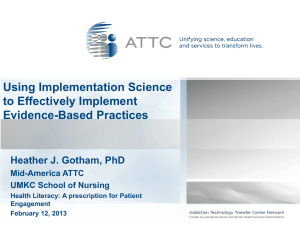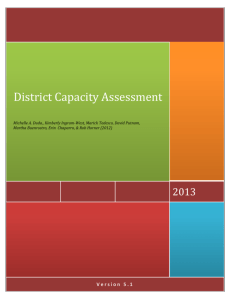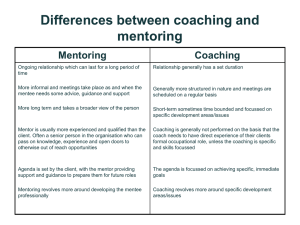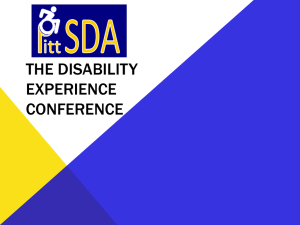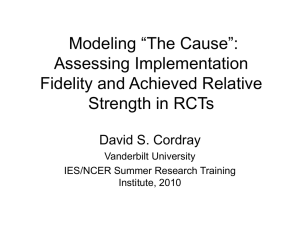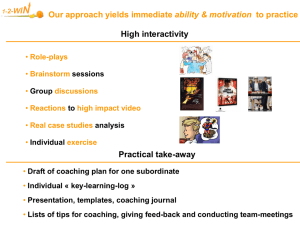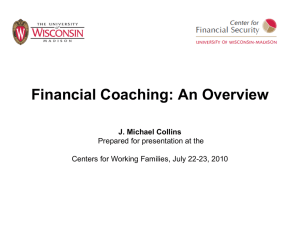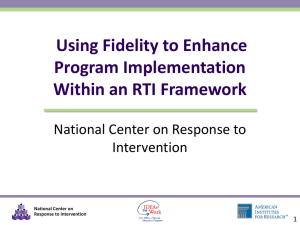Planning for Success
advertisement
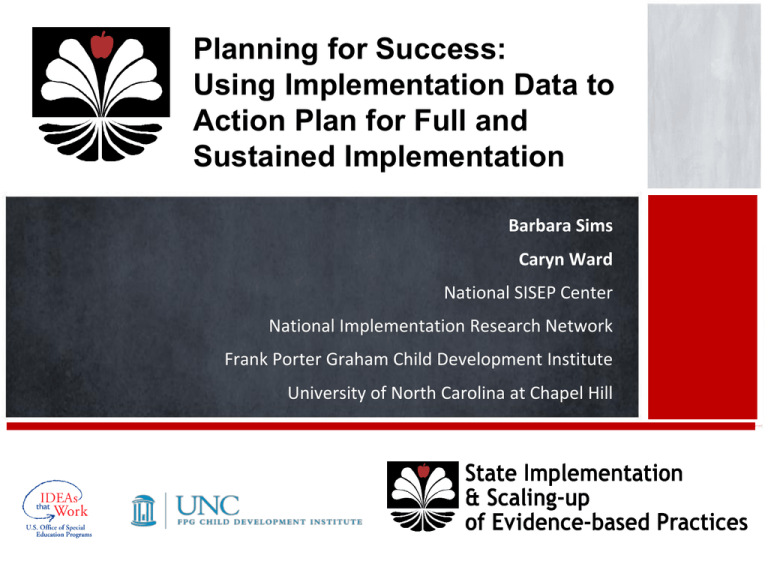
Planning for Success: Using Implementation Data to Action Plan for Full and Sustained Implementation Barbara Sims Caryn Ward National SISEP Center National Implementation Research Network Frank Porter Graham Child Development Institute University of North Carolina at Chapel Hill Implementation Quick Start Formula for Success Formula for Success (continued) IMPLEMENTATION TEAMS Organized, expert assistance to develop and sustain an accountable and effective structure Implementation Teams Linked Team Structures Cascading Model Quality Instruction Implementation Team Supports School Leadership Enabling District Context Enabling State Context Enabling District Context School Leadership Implementation Team Supports Quality Instruction Student Outcomes SISEP Assessments Students Cascading Logic Model Population Intervention Strategies (WHAT) Intervention Outcomes Students Educators skillfully implement evidencebased intervention strategies. Socially significant improvements in academic, social, emotional or behavioral outcomes for students. SISEP Assessments Educators Cascading Logic Model Population Intervention Strategies (WHAT) Intervention Outcomes Students Educators skillfully implement evidence-based intervention strategies. Socially significant improvements in academic, social, emotional or behavioral outcomes for students. Population Implementation Strategies (HOW) Implementation Outcomes Educators Provision of skillful, timely training, coaching, and performance assessments in supportive administrative environments organized by building and district leadership Educators skillfully implement evidence-based intervention strategies. Population Students Population Cascading Logic Model Intervention Strategies (WHAT) Educators skillfully implement evidence-based intervention strategies. Implementation Strategies (HOW) Intervention Outcomes Socially significant improvements in academic, social, emotional or behavioral outcomes for students. Implementation Outcomes Educators Provision of skillful, timely training, coaching, and performance assessments in supportive administrative environments organized by building and district leadership Educators skillfully implement evidence-based intervention strategies. Schools and Districts Systemic professional development leadership and planning to ensure high quality, consistent training and coaching through the use of fidelity and outcome data, and the development of facilitative administrative practices and policies to support implementation Provision of skillful, timely training, coaching, and performance assessments in supportive administrative environments organized by building and district leadership Population Implementation Strategies (HOW) Implementation Outcomes Schools and Districts Systemic professional development leadership and planning to ensurSce high quality, consistent training and coaching through the use of fidelity and outcome data, and the development of facilitative administrative practices and policies to support implementation Provision of skillful, timely training, coaching, and performance assessments in supportive administrative environments organized by building and district leadership Regions and States Common mission for professional development Formal structures created to build policy–practice feedback loops Review of funding streams to support new functions and relationships Collaborative partnerships to build professional development system infrastructure Fidelity and outcome data systems developed and maintained Systemic professional development leadership and planning to ensure high quality, consistent training and coaching through the use of fidelity and outcome data, and the development of facilitative administrative practices and policies to support implementation Population Implementation Strategies (HOW) Implementation Outcomes Regions and States Common mission for professional development Formal structures created to build policy–practice feedback loops Review of funding streams to support new functions and relationships Collaborative partnerships to build professional development system infrastructure Fidelity and outcome data systems developed and maintained Systemic professional development leadership and planning to ensure high quality, consistent training and coaching through the use of fidelity and outcome data, and the development of facilitative administrative practices and policies to support implementation Increase knowledge of evidencebased implementation supports for evidence-based practices in SEAs, LEAs and TA Centers Provide resources and TA to establish implementation infrastructures in SEAs and LEAs Provide resources and assessment tools to measure fidelity and implementation outcomes Common mission for professional development Formal structures created to build policy–practice feedback loops Review of funding streams to support new functions and relationships Collaborative partnerships to build professional development system infrastructure Fidelity and outcome data SISEP Center Logic Model SISEP Center Try It Now! Monitoring Implementation Progress Assessing Implementation Identify 2-3 indicators to help monitor the work of these teams Tools and Assessments State Capacity Assessment (SCA) Purpose: Measure of state and regional capacity for implementation of evidence-based practices and other effective innovations Provides a structured process for the development of a State Capacity Action Plan Administration: Completed by State Management Team/Implementation Team 2x a year SCA Scoring key All Scaling Capacity Items scored using the following format. - All dimensions of element adhered to and evidence available to support this rating Fully In Place 2 points Partially In Place 1 point - Some dimensions of element adhered to and/or some dimensions attended to - Action Planning occurs with these elements Not in Place 0 points - Element not adhered to Action Planning occurs with these elements or teams may not be developmentally ready to implement this component State Capacity Assessment: SMT Section SISEP.Org SCA Results: Total Score SCA Results: SubScale SCA Results: Sub-Subscale Next Step – Action Planning Review Items with scores of 0 and 1 Identify several items for action planning that may be completed within the next 3 months Look for Quick wins Define the Action Determine: » Who is responsible » When it will be accomplished » Progress monitoring schedule for problem solving SAMPLE ACTION PLAN District Capacity Assessment (DCA) Purpose: Measure of the capacity for implementation of effective innovations in schools, districts, and regions in the state Provide a structured process for the development of a District Capacity Action Plan Administration: Completed by District Implementation Team 2x a year DLIT!report!! A.4!Most!recent!DLIT!report! ! to!District! DCA!data! Board/Community! Stakeholders!includes! information!about:! (a)!school!level!fidelity!to! intervention!processes!and! (b)!student!outcomes!! ! (May!also!include!DCA!data)3 Interview!DLIT!members! ! DLIT!facilitator/coordinator! job!description! ! Interview!DLIT! facilitator/coordinator! ! ! ! A.5!DLIT!includes!an! identified!facilitator/! coordinator!with!the!FTE! (time)!knowledge!of! Implementation!Science! and!responsibility!to!assist! the!DLIT!to!meet,!process! and!manage!DLIT!tasks! A.6!DLIT!has!at!least!a! three?year!budget!plan!to! support!implementation!of! any!new!selected!evidence? based!practices!! ! ' DLIT!budget!! ! Long!Range!Budget!Plan! ! 0!=!Report!does!not!include! ! Fidelity!or!Outcome! information! ! 1!=!Report!includes!Fidelity!OR! Outcome!information,!but!not! both! ! 2!=!Report!includes!both! Fidelity!AND!Outcome! information! ! 0=!DLIT!does!not!include!a! ! designated! facilitator/coordinator! ! 1=!DLIT!has!a!designated! facilitator,!but!the! facilitator/coordinator!does!not! have!enough!time!or!a! corresponding!job!description! to!adequately!fulfill!! ! 2=!DLIT!has!a!designated! facilitator/coordinator!with! adequate!FTE!to!fulfill!roles!and! responsibilities! 0=!No!dedicated!funding! ! ! 1=Dedicated!funding!for!new! EBP!implementation,!but!less! than!3!years! ! 2=!At!least!three!years!of! funding!to!support! implementation!of!EBPs! DCA Results Observation Tool for Instructional Supports and Systems (OTISS) Purpose: Measure of the quality of systems and supports available to help teachers use best practices for instruction Implementation Team accountability NOT teacher accountability OTISS: Development Hattie (2009) meta-meta-analysis Select instruction practices Evidence-based (demonstrated to improve student outcomes) Observable in a 10-minute segment of instruction Not event/time related (any 10-minute segment) Content Free Applicable to any grade level OTISS Screenshot OTISS Usability Testing Data (all schools) OTISS Usability Testing Data (by school) OTISS Usability Testing Data (by intervention) Cascading Model & Measures Student outcomes (monthly data) OTISS (every teacher, 3x semester) DCA (2-3X a year) RIT (SCA: 2X a year) SMT/STS (SCA: 2X a year) Try It Now! (continued) Using Data for Action Planning Action Planning & State Capacity Assessment Utilizing the provided sample results of the SCA, identify at least 2-3 next steps. Cascading Logic Model: Putting it all together GET CONNECTED! http://www.scalingup.org @SISEPcenter SISEP For more on Implementation Science http://nirn.fpg.unc.edu http://www.globalimplementation.org For More Information Barbara Sims Caryn Ward, Ph.D. 919-843-8751 919-843-5787 barbara.sims@unc.edu caryn.ward@unc.edu Frank Porter Graham Child Development Institute University of North Carolina Chapel Hill, NC Frank Porter Graham Child Developmenthttp://nirn.fpg.unc.edu/ Institute University of North Carolina http://www.scalingup.org Chapel Hill, NC http://implementation.fpg.unc.edu http://nirn.fpg.unc.edu/ http://www.scalingup.org http://implementation.fpg.unc.edu GIC 2015 Dublin, Ireland ©Copyright Dean Fixsen and Karen Blase This content is licensed under Creative Commons license CC BY-NC-ND, Attribution-NonCommercial-NoDerivs. You are free to share, copy, distribute and transmit the work under the following conditions: Attribution — You must attribute the work in the manner specified by the author or licensor (but not in any way that suggests that they endorse you or your use of the work); Noncommercial — You may not use this work for commercial purposes; No Derivative Works — You may not alter or transform this work. Any of the above conditions can be waived if you get permission from the copyright holder. http://creativecommons.org/licenses/by-nc-nd/3.0
